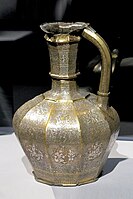Blacas ewer

The Blacas ewer is a brass ewer, inlaid with silver and copper, made by an esteemed man, Shuja' ibn Man'a al-Mawsili in Mosul in April or May 1232 (Rajab, 629 AH).[1] One of the most important and well-known pieces of metalwork from Mosul, it was likely commissioned for Badr al-Din Lu'lu', who was already the de facto ruler of Mosul when the ewer was made and who officially became ruler one year later.[1] Until 1997, the Blacas ewer was the only known piece of metalwork with an inscription explicitly saying it was made in Mosul.[2]: 12 : 23 Because of this inscription, it forms one of the core items of the contested "Mosul School" of metalwork, since its Mosuli provenance is undisputed.[2]: 23, 30
The Blacas ewer is the only known work by Shuja' ibn Man'a.[2]: 23 It formed the part of the personal collection of the French antiquarian Pierre Louis Jean Casimir de Blacas, which was published in 1828.[2]: 12 It is now on display at the British Museum in London, which has owned it since 1866.[1]
The Blacas Ewer is missing its foot and spout, but it doesn’t take away from the beautiful designs, structure, and origins of the ewer. It is decorated with a geometric fretwork background punctuated by several small and large multi-lobed medallions.[1] Inside the medallions are figural scenes depicting a wide variety of courtly activities: hunting, sports, and feasts with music and dance.[1] There are also literary scenes, such as a depiction of Bahram Gur hunting on camelback while Azadeh plays the harp by his side—a story from the Shahnama.[1] Several scenes depict "women of high social rank": for example, one scene depicts a woman riding a camel, another depicts a veiled woman playing the lute, and another shows a woman sitting cross-legged while admiring herself in the mirror.[1] The overall design composition is reminiscent of Chinese textiles, which may have served as an inspiration.[1] In this case, though, the design is interrupted by an octagonal symbol filled with geometric patterns, which may have been a brand mark or guild emblem.[2]: 30–1
The scenes illustrated on the ewer depict contemporary life of the wealthy and powerful, likely reflecting the high status of its original owner.[3]
-
Blacas Ewer, Mosul, 1232, British Museum.
-
Blacas ewer, combat scene.
External links[edit]
References[edit]
- ^ a b c d e f g h Beyazit, Deniz (2016). "The Blacas ewer". Court and Cosmos: The Great Age of the Seljuqs. New York: Metropolitan Museum of Art. p. 75. ISBN 978-1-58839-589-4. Retrieved 26 November 2022.
- ^ a b c d e Raby, Julian (2012). "The Principle of Parsimony and the Problem of the 'Mosul School of Metalwork'". In Porter, Venetia; Rosser-Owen, Mariam (eds.). Metalwork and Material Culture in the Islamic World (PDF). Bloomsbury Publishing. pp. 11–85. ISBN 9780857733436. Retrieved 18 November 2022.
- ^ Bloom, Jonathan; Blair, Sheila (1997). Islamic Arts. Phaidon. p. 275.
- ^ "Blacas ewer British Museum". www.britishmuseum.org.
- ^ "Blacas ewer British Museum". www.britishmuseum.org.
- ^ Court and Cosmos: The Great Age of the Seljuqs (PDF). Metropolitan Museum of Art. 2014. p. 75.


![Hunting scene on the Blacas ewer, 1232, Mosul, Zengid dynasty.[4]](http://upload.wikimedia.org/wikipedia/commons/thumb/e/e0/Blacas_ewer%2C_hunting_scene.jpg/200px-Blacas_ewer%2C_hunting_scene.jpg)
![Regnal scene on the Blacas ewer, 1232, Mosul, Zengid dynasty.[5]](http://upload.wikimedia.org/wikipedia/commons/thumb/6/6b/Blacas_ewer%2C_regnal_scene.jpg/200px-Blacas_ewer%2C_regnal_scene.jpg)

![Blacas ewer, ruler wearing the Turkic hat sharbush, with attendants.[6]](http://upload.wikimedia.org/wikipedia/commons/thumb/6/62/Blacas_ewer%2C_ruler_wearing_sharbush%2C_with_attendants.jpg/200px-Blacas_ewer%2C_ruler_wearing_sharbush%2C_with_attendants.jpg)